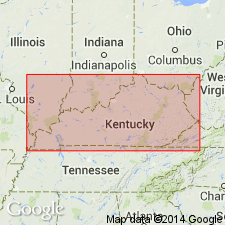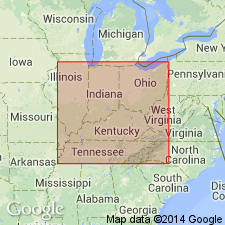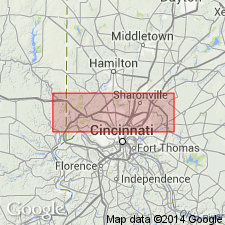
- Usage in publication:
-
- Belfast bed
- Modifications:
-
- Named
- Dominant lithology:
-
- Limestone
- Shale
- AAPG geologic province:
-
- Cincinnati arch
Summary:
Name Belfast bed introduced for unfossiliferous sandy and argillaceous limestone, in places clayey shale, 3 to 6 feet thick. Formerly, but incorrectly, called Medina. Overlies Cincinnati formation and underlies Clinton or Montgomery formation [Brassfield limestone]. Included in Lower Silurian [Ordovician] of OH and southeastern IN. [For many years regarded as top bed of Richmond group.]
Source: GNU records (USGS DDS-6; Reston GNULEX).

- Usage in publication:
-
- Belfast
- Modifications:
-
- Not used
- AAPG geologic province:
-
- Cincinnati arch
Summary:
The term Belfast proposed for an arenaceous limestone in Highland and Adams Cos., OH, was dropped when it was learned that it could be traced laterally into limestone strata containing a typical Brassfield fauna. The Belfast is merely a local phase of the base of the Brassfield.
Source: GNU records (USGS DDS-6; Reston GNULEX).

- Usage in publication:
-
- Belfast bed, formation
- Modifications:
-
- Overview
- AAPG geologic province:
-
- Cincinnati arch
Summary:
East of the Cincinnati anticline, base of typical Brassfield limestone is underlain by argillaceous, bluish, usually massive limestone, 3 to 6 ft thick, which contains annelid teeth at Todd Fork (north of Wilmington, OH) at Sharpsville (in northwest margin of Highland Co.), and at Belfast (in southeast corner of Highland Co.). Presence of HALYSITES in this limestone suggests Silurian age, though a distinguishable species is known also from Richmond beds in other areas. Writer in 1896 named this argillaceous limestone Belfast bed or formation.
Source: GNU records (USGS DDS-6; Reston GNULEX).

- Usage in publication:
-
- Belfast Member
- Modifications:
-
- Overview
- AAPG geologic province:
-
- Cincinnati arch
Summary:
Belfast Member of Brassfield Formation described from sections in south-central OH and northeastern KY. Overlies Preachersville Member of Drakes Formation (Late Ordovician). Age is Early Silurian.
Source: GNU records (USGS DDS-6; Reston GNULEX).
For more information, please contact Nancy Stamm, Geologic Names Committee Secretary.
Asterisk (*) indicates published by U.S. Geological Survey authors.
"No current usage" (†) implies that a name has been abandoned or has fallen into disuse. Former usage and, if known, replacement name given in parentheses ( ).
Slash (/) indicates name conflicts with nomenclatural guidelines (CSN, 1933; ACSN, 1961, 1970; NACSN, 1983, 2005, 2021). May be explained within brackets ([ ]).

